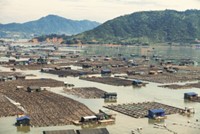Advertisement
Grab your lab coat. Let's get started
Welcome!
Welcome!
Create an account below to get 6 C&EN articles per month, receive newsletters and more - all free.
It seems this is your first time logging in online. Please enter the following information to continue.
As an ACS member you automatically get access to this site. All we need is few more details to create your reading experience.
Not you? Sign in with a different account.
Not you? Sign in with a different account.
ERROR 1
ERROR 1
ERROR 2
ERROR 2
ERROR 2
ERROR 2
ERROR 2
Password and Confirm password must match.
If you have an ACS member number, please enter it here so we can link this account to your membership. (optional)
ERROR 2
ACS values your privacy. By submitting your information, you are gaining access to C&EN and subscribing to our weekly newsletter. We use the information you provide to make your reading experience better, and we will never sell your data to third party members.
Environment
Deadly E. Coli Strain May Evade EPA's Test
Water Pollution: Researchers find a weakness in a method to identify contaminated water
by Sara Peach
February 16, 2011

In 2006, about 200 people fell sick, 100 were hospitalized, and three died when they ate spinach tainted by the pathogen Escherichia coli O157:H7. Because of this bacterial strain's virulence, regulators would like to know when it's present in surface waters. But a common method of detecting the bacteria may miss it, according to a new study (Environ. Sci. Technol., DOI: 10.1021/es1032019).
E. coli O157:H7 is a bacterial strain that can cause vomiting, bloody diarrhea, and kidney failure. The pathogen lives in the digestive systems of cattle, feral swine, and wild animals, and it can infiltrate lakes, rivers and streams through the animals' waste. Accurate detection is critical to protecting public health, because ingesting only a small number of E. coli O157:H7 cells can cause illness.
Since the 1980s, the Environmental Protection Agency and other regulators have tested for pathogens like E. coli O157:H7 in water by looking for fecal bacteria. These indicator microbes are harmless, easy-to-measure inhabitants of animal and human gastrointestinal tracts. But their presence in a body of water suggests that dangerous microorganisms spread through feces may also be present.
Previous research had raised questions about whether E. coli O157:H7 outlasts indicator bacteria in the environment. So Michael Jenkins and his colleagues at the U.S. Department of Agriculture's Agricultural Research Service decided to test the reliability of the EPA's method by measuring the survival rates of E. coli O157:H7 and four species of indicator bacteria. In one experiment, they injected the E. coli strain and the indicator bacteria into small, porous chambers and then suspended the chambers in test ponds in northeast Georgia. By varying the chambers' depth in the water, the scientists could monitor the microbe's survival rate under different levels of solar radiation. In another experiment, they placed inoculated pond water in bottles in an outdoor laboratory. The researchers then measured bacteria levels at regular intervals. Both experiments exposed the bacteria to predation by other microorganisms—a common fate of microbes in the environment.
They found that in both experiments, the indicator bacteria died off significantly more quickly than E. coli O157:H7 did. For example, in the outdoor lab experiments, most cells of fecal Enterococcus—an indicator species—died in less than five days. But it took between seven and 18 days for most of the E. coli O157:H7 to die. The virulent strain appeared to be more resistant than indicator bacteria to solar radiation and to predation by other microorganisms. The findings suggest that the dangerous E. coli could be present in water even when tests for fecal indicator bacteria are negative, Jenkins says. "We need to develop methods that are going to be able to quantify the pathogens themselves," he says.
But developing and deploying tests for every dangerous microorganism would be expensive, says Michele Jay-Russell, a food safety specialist at the University of California, Davis' Western Center for Food Safety. And because E. coli O157:H7 occurs only rarely in the environment, regulators would have to collect large numbers of samples to find an outbreak, even with methods that are more reliable than fecal indicator tests, she says. She adds that for routine monitoring, developing a test for virulent strains wouldn't be cost effective.
But Jay-Russell says that the new research demonstrates the importance of using multiple methods simultaneously to monitor water quality. For example, the EPA often monitors the areas around water bodies for sources of fecal contamination and looks for nearby outbreaks of bacterial infections in people. "Indicator testing is not a standalone," she says. "It definitely has limitations."





Join the conversation
Contact the reporter
Submit a Letter to the Editor for publication
Engage with us on Twitter